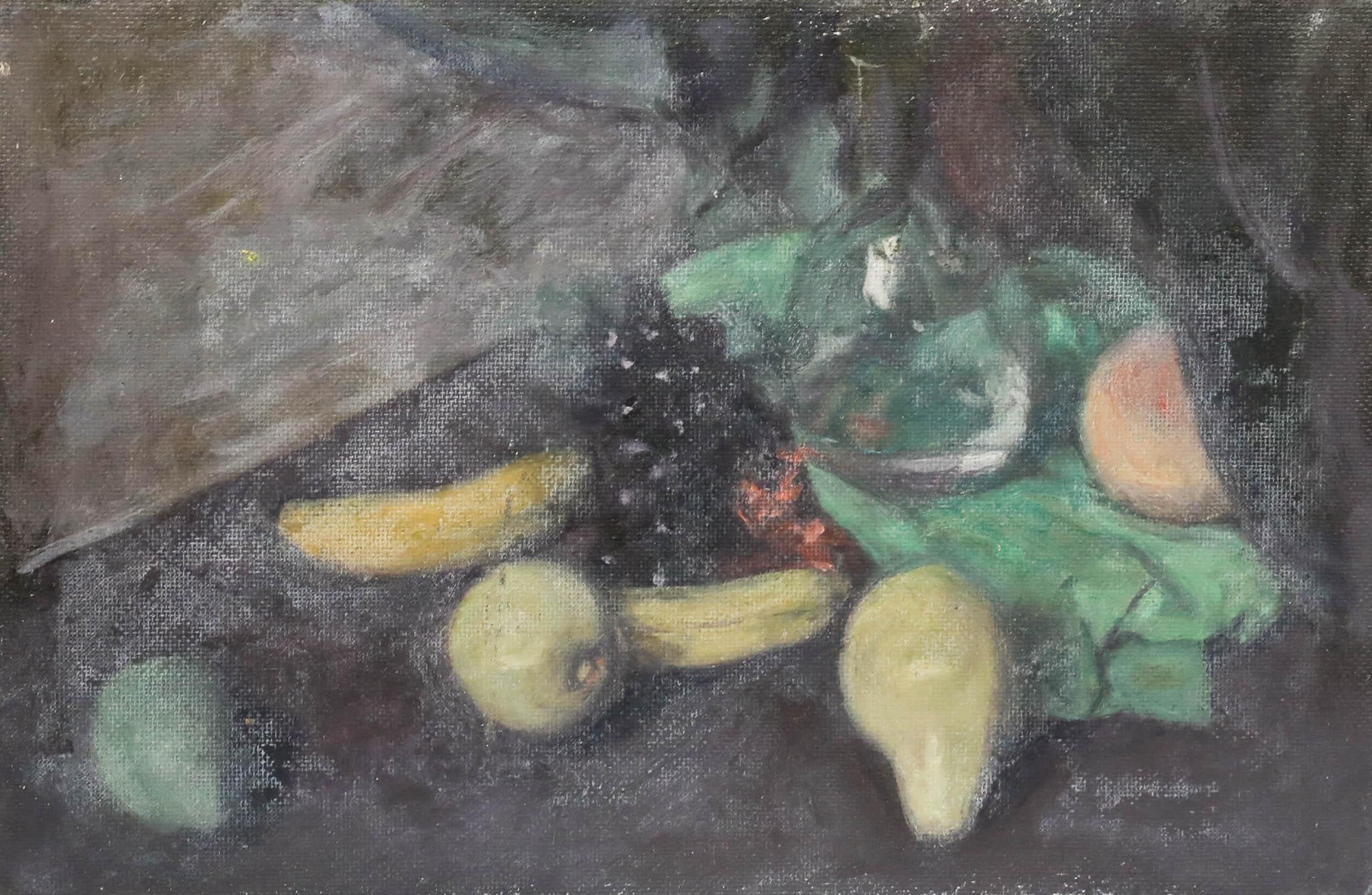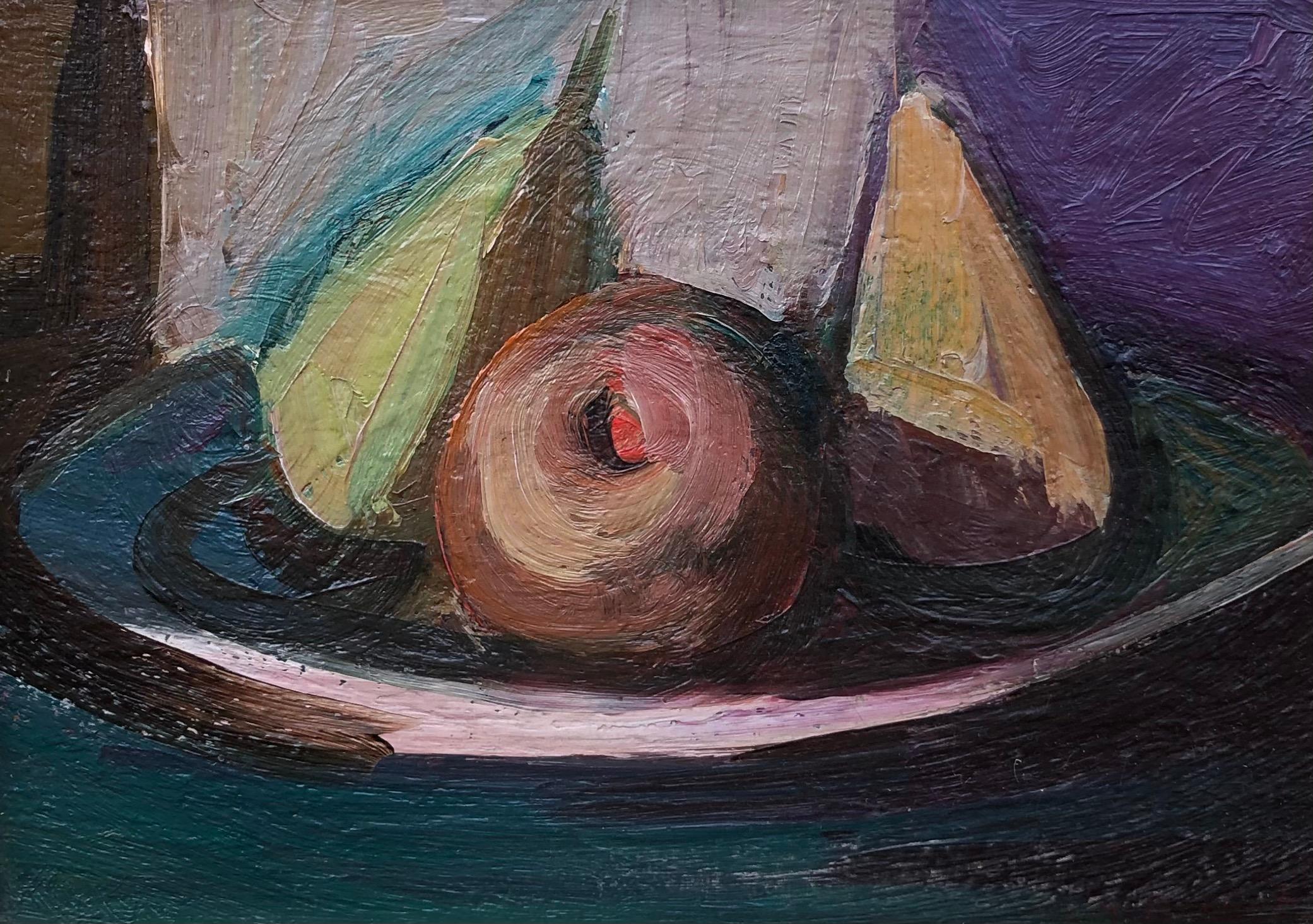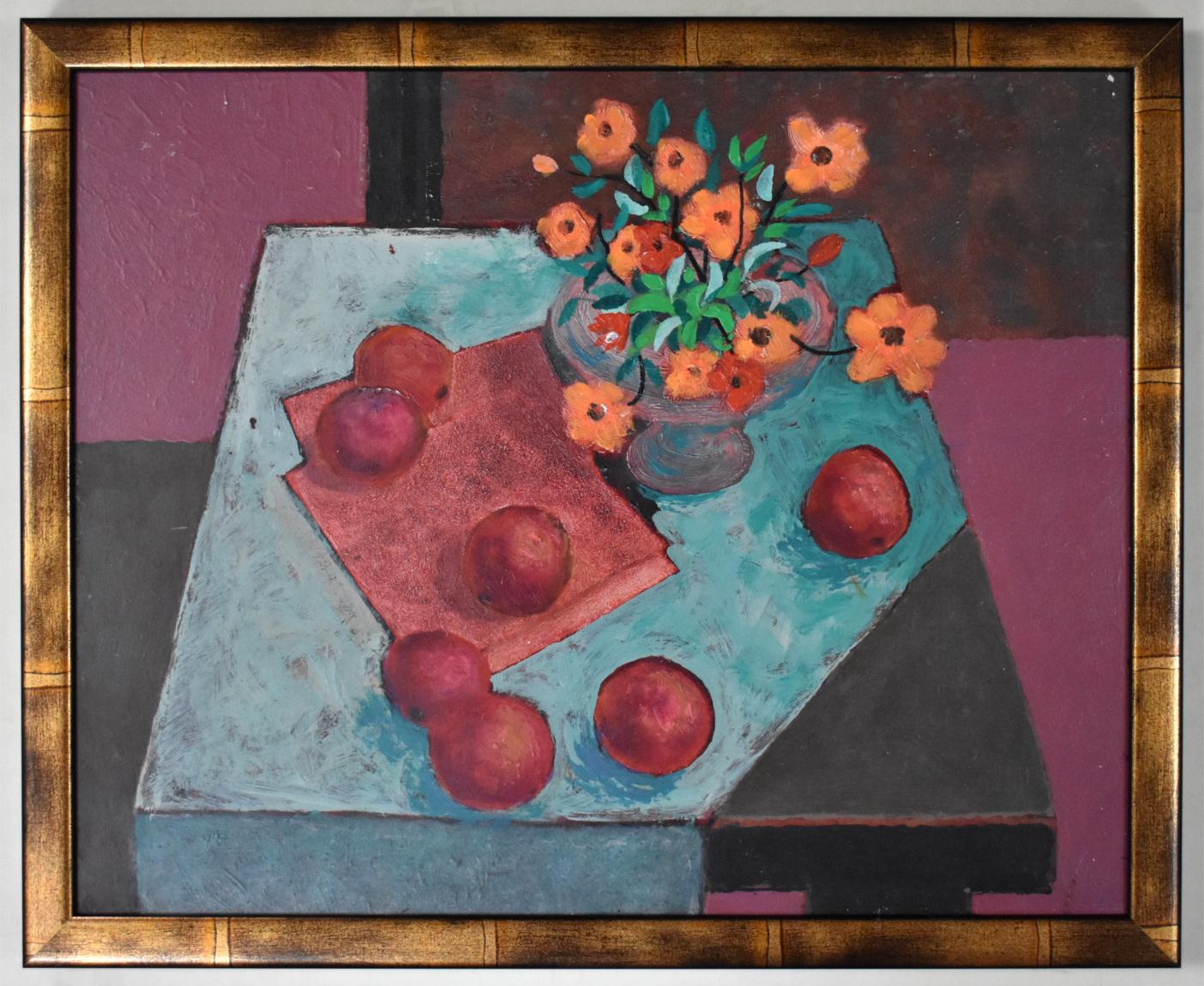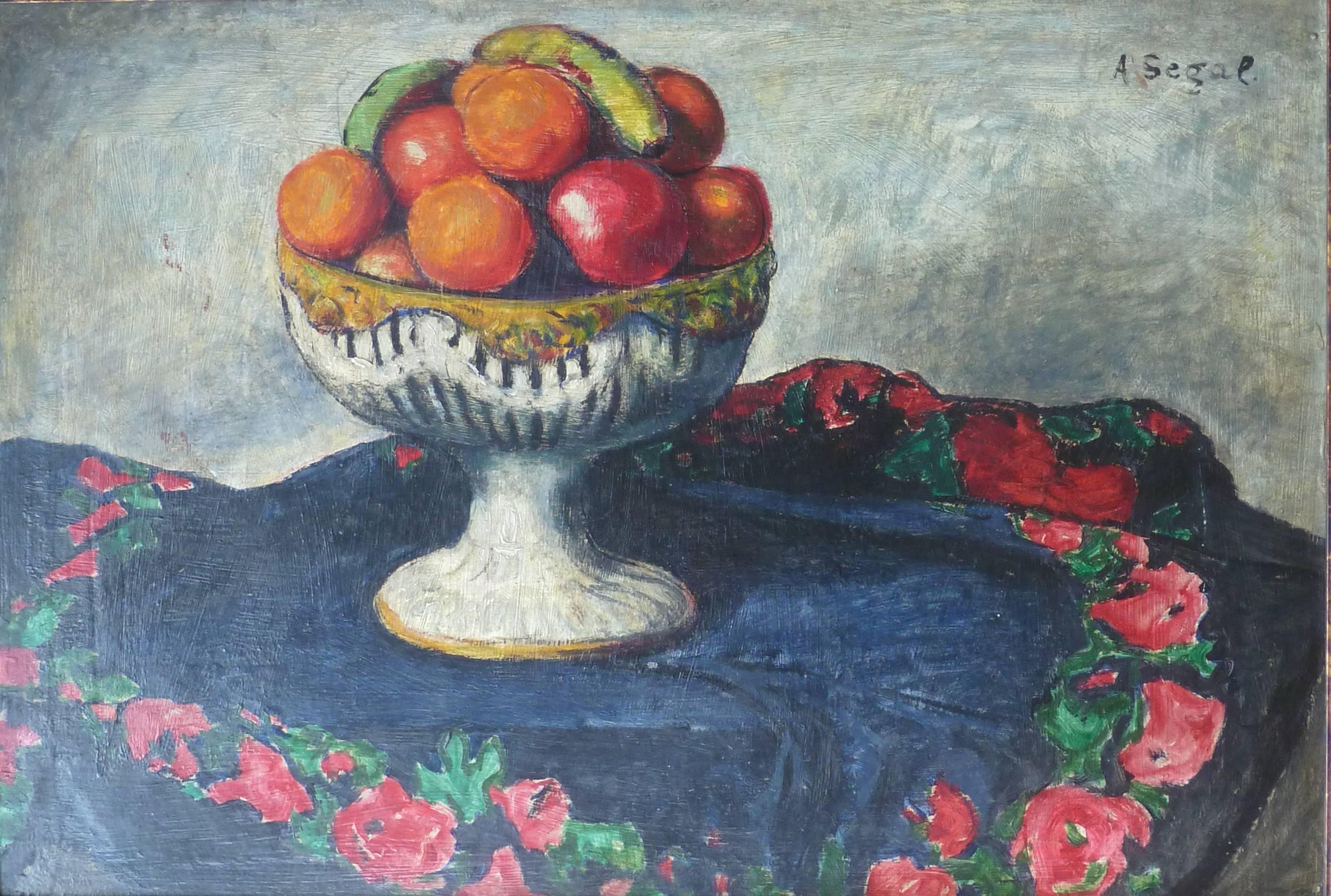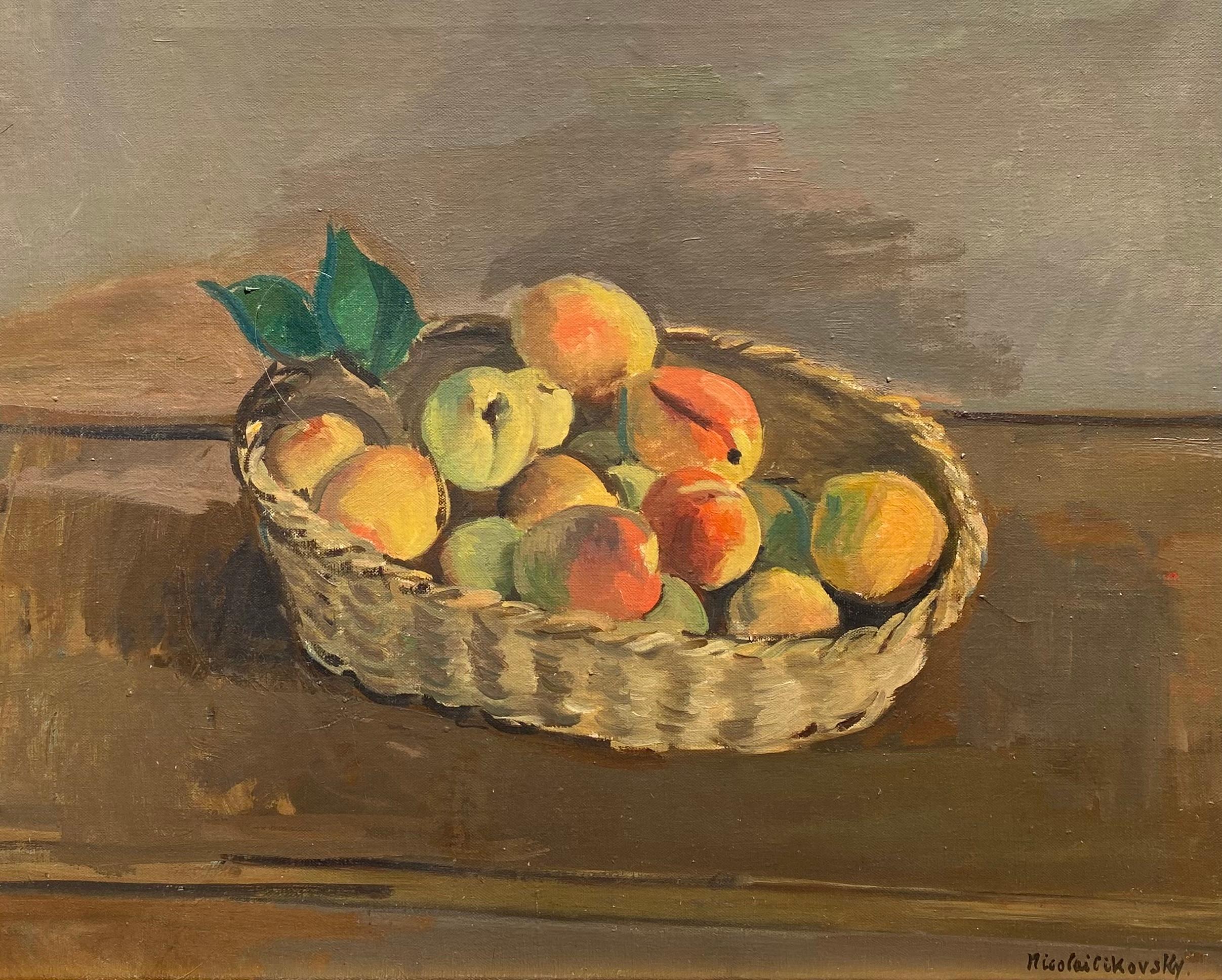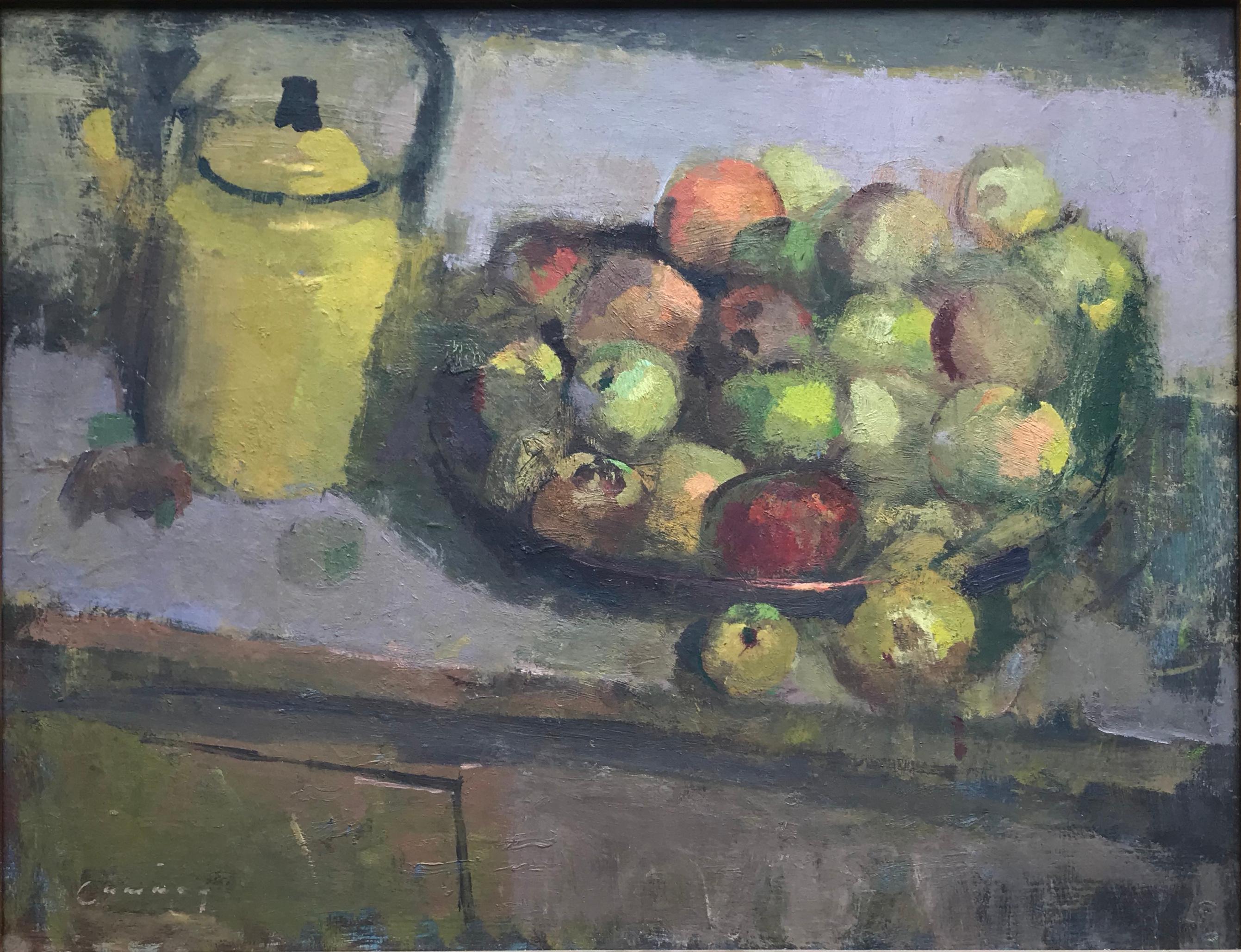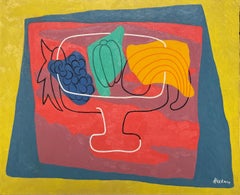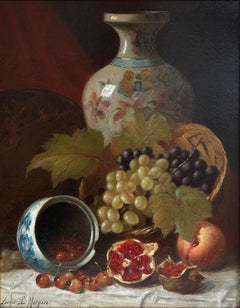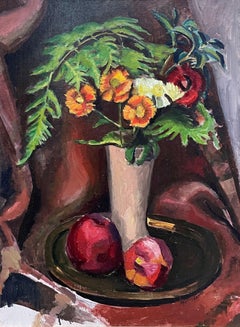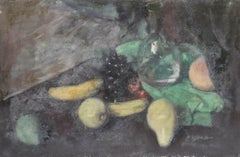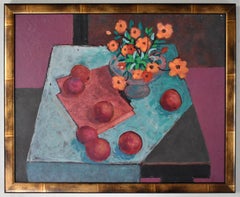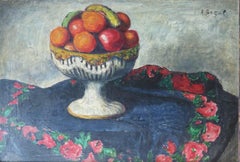Items Similar to "Still Life of Fruit " Albert Swinden, American Abstract Association, AAA
Want more images or videos?
Request additional images or videos from the seller
1 of 10
Albert Swinden"Still Life of Fruit " Albert Swinden, American Abstract Association, AAA1937
1937
$4,800
$6,00020% Off
£3,636.91
£4,546.1420% Off
€4,173.07
€5,216.3320% Off
CA$6,754.37
CA$8,442.9720% Off
A$7,424.92
A$9,281.1520% Off
CHF 3,902.20
CHF 4,877.7420% Off
MX$90,165.52
MX$112,706.9120% Off
NOK 48,678.91
NOK 60,848.6320% Off
SEK 46,119.84
SEK 57,649.8020% Off
DKK 31,144.65
DKK 38,930.8120% Off
About the Item
Albert Swinden (1901 - 1961)
Still Life of Fruit, 1937
Oil on canvas
18 x 30 inches
Provenance:
Graham Gallery, New York
Albert Swinden (1901–1961) was an English-born American abstract painter. He was one of the founders of the American Abstract Artists, and he created significant murals as part of the Federal Art Project.
Albert Swinden was born in Birmingham, England in 1901. When he was seven, he moved with his family to Canada, and in 1919 he immigrated to the United States. He lived in Chicago, where he studied for about a year and a half at the Art Institute. He then relocated to New York City, where his art education continued briefly at the National Academy of Design. He soon changed schools again, to the Art Students League, which he attended from 1930 to 1934. He studied with Hans Hofmann and gained an appreciation for Synthetic Cubism and Neoplasticism. According to painter and printmaker George McNeil, Swinden "could have influenced Hofmann ... He was working with very, very simple planes, not in this sort of Cubistic manner. Swinden was working synthetically at this time." While still a student, Swinden began teaching at the Art Students League, in 1932.
Swinden married Rebecca Palter (1912–1998), from New York. Their daughter, Alice Swinden Carter, also became an artist. Carter, who attended the School of the Museum of Fine Arts, Boston, received an award from the Institute of Contemporary Art, Boston for her large sculptures.
Swinden was hired for the Federal Art Project (FAP) of the Works Progress Administration (WPA), and he is best known for the murals which he painted as part of that project.
In 1935, New York City Mayor Fiorello La Guardia attended the opening of the inaugural exhibit at the Federal Art Project Gallery, accompanied by Audrey McMahon, New York regional director for the Works Progress Administration/Federal Art Project. Among the works on display was Abstraction, a sketch by Swinden; it was the design for a mural planned for the College of the City of New York. A newspaper account described it as consisting of "brightly colored T-squares, triangles and rulers in horizontal, vertical and diagonal positions". La Guardia asked what it was, and upon being told it was a mural design, he said he didn't know what it depicted. Someone joked that it could be a map of Manhattan. The displeased mayor stated that "if that's art, I belong to Tammany Hall." (Tammany Hall, which the Republican mayor referenced, was the New York Democratic Party political society.) Fearing that the mayor's negative attitude could jeopardize the future of abstract art within the Federal Art Project, McMahon dispatched an assistant to summon an artist who could speak to the mayor in defense of abstraction. The assistant returned with Arshile Gorky.
Swinden played an important role in the founding of the American Abstract Artists. In 1935, he met with three friends, Rosalind Bengelsdorf, her future husband Byron Browne, and Ibram Lassaw, with the goal of exhibiting together. The group grew and started meeting in Swinden's studio, which adjoined those of Balcomb and Gertrude Greene. The A.A.A. evolved in 1937 out of these meetings among twenty-two artists.
One of the artists attending those meetings was painter John Opper, who said in an interview that Swinden was very quiet, shy, and inhibited. He also said that Swinden was one of the best painters in the group. "His paintings were very powerful, very strong. You would think he would be one of those robust persons like Gorky, for instance. But he was the opposite of Gorky. He was very withdrawn." Around this time, Swinden may have painted abstracts exclusively. But later, according to Irving Sandler, "it was sort of a mixture between figurative and geometric abstraction. It was a kind of hard-edge figure towards the end."
Burgoyne Diller selected Swinden to create a mural for Brooklyn's Williamsburg Housing Project. The other artists chosen for this project were Paul Kelpe, who painted two murals, and Ilya Bolotowsky and Balcomb Greene, each of whom created one. The murals were commissioned in 1936 by the Mural Division of the WPA/FAP in New York. Diller headed the Mural Division.
Swinden's large – 9.31 by 14.36 feet (2.84 m × 4.38 m) – untitled abstract mural has been described as a "carefully balanced, disciplined composition of rectangular shapes punctuated by occasional biomorphic forms". He was not able to execute the mural exactly as he had originally conceptualized, due to constraints of the installation space; for example, the unpainted upper corners which were inserted during restoration are where structural beams were present at the Williamsburg site. The black strip at the top and the broken blue one on the right were probably also changes made due to requirements of using the particular space.
The murals, owned by the New York City Housing Authority, are on loan to the Brooklyn Museum. These five paintings were the first abstract murals anywhere in the United States, and they're considered to be some of the most significant. Art historians have praised the murals as "extremely important artworks, quite courageous and extraordinary ... painted in the most radical style you could get at the time", "key to American art between the wars", and "national treasures".
Among the other murals he created was one for the 1939 New York World's Fair.
Although he did not often write about his art, a short essay of his was published in the American Abstract Artists Yearbook of 1938. This yearbook featured, among other things, essays such as Swinden's which expounded on theories and practices of abstract art. In his essay, "On Simplification", Swinden wrote: "We are moved not only by particular, or individual forms, but by the relationships between the particular forms and their significance as a unity."
A 1940 fire at Swinden's studio destroyed the majority of his early work. His mural for the Williamsburg Project, which had been painted over and considered lost before being rediscovered and restored, is a rare and very significant painting from the period before the fire.
In a 1942 review of the American Abstract Artists' sixth annual exhibition, influential art critic Clement Greenberg wrote that among the "geometricians", Swinden "shows as much promise perhaps in his single unsuccessful painting as the others in their successful ones."
Although he was respected by the prominent artists he associated with, had his paintings exhibited in many group shows (including such prestigious venues as the Museum of Modern Art, the Solomon R. Guggenheim Museum and the Whitney Museum of American Art), and created significant murals, he was not able to promote his art in a commercially successful way. Instead, he often had to work in other capacities, supporting himself as an engineering draftsman or a textile designer.
He died in 1961 in New York City. In 1962, a retrospective exhibit of his work was mounted at New York's Graham Gallery. Swinden left behind a relatively small oeuvre of "calmly classical visions".
About the Seller
5.0
Platinum Seller
Premium sellers with a 4.7+ rating and 24-hour response times
Established in 2022
1stDibs seller since 2022
122 sales on 1stDibs
Typical response time: <1 hour
- ShippingRetrieving quote...Shipping from: New York, NY
- Return Policy
Authenticity Guarantee
In the unlikely event there’s an issue with an item’s authenticity, contact us within 1 year for a full refund. DetailsMoney-Back Guarantee
If your item is not as described, is damaged in transit, or does not arrive, contact us within 7 days for a full refund. Details24-Hour Cancellation
You have a 24-hour grace period in which to reconsider your purchase, with no questions asked.Vetted Professional Sellers
Our world-class sellers must adhere to strict standards for service and quality, maintaining the integrity of our listings.Price-Match Guarantee
If you find that a seller listed the same item for a lower price elsewhere, we’ll match it.Trusted Global Delivery
Our best-in-class carrier network provides specialized shipping options worldwide, including custom delivery.More From This Seller
View All"Fruit" Georgina Klitgaard, Apples and Pears Still Life, Woodstock Female Artist
By Georgina Klitgaard
Located in New York, NY
Georgina Klitgaard
Apples and Pears Still Life
Signed lower right
Oil on canvas
8 x 10 inches
Georgina Klitgaard’s art has sometimes gotten lost in the critical propensity to assign artists to membership in one school or another. Unfortunately for her posthumous reputation, Klitgaard defied easy characterization. She was a U.S. modernist, working in both oil and watercolors, but never abandoned figurative painting. She made her reputation in landscape but also excelled in portraits, flower studies, and even cityscapes. Yet despite Klitgaard’s ambiguous status in art history, her paintings continue to fascinate viewers attracted to the unsteady ground between twentieth-century realism and expressionism.
Georgina Klitgaard (née Berrian) was born in Spuyten Duyvil, New York (now part of the Bronx); the Berrians had lived in the area since at least the U.S. Revolution. After graduating from Barnard College, she studied art at the National Academy of Design. In 1919 she married Kay Klitgaard, a Danish artist and writer. The next year, her life took a decisive turn when the couple visited friends in Woodstock, NY—about 120 miles north of New York City--and fell in love with the area.
In 1906, L. Birge Harrison helped found the Art Students League Summer School in Woodstock and the area became a magnet for landscape painters. The Klitgaards bought a house in 1922 on a steep ledge at the end of Cricket Ridge, high above Bearsville, which provided panoramic vistas overlooking the Catskill Mountains and the Hudson Valley. Klitgaard joined the artists’ colony in the area, which at the time included artists Ernest Fiene and Katherine Schmidt.
Klitgaard exhibited widely and her career slowly developed momentum. She was a regular contributor at Whitney Museum shows from 1927 to 1944. In 1929, she exhibited a painting entitled “Carousel” in the Whitney Studio Club’s famous exhibition “Circus in Paint.” Gertrude Vanderbilt Whitney acquired five paintings by Klitgaard in the early 1930s and served as a significant patron for the artist. Klitgaard s New York dealer, Frank Rehn...
Category
Early 20th Century Modern Still-life Paintings
Materials
Canvas, Oil
"Untitled" Albert Heckman, circa 1950 Modernist Colorful Still Life With Fruit
By Albert Heckman
Located in New York, NY
Albert Heckman
Untitled, circa 1950
Signed lower right
Oil on canvas
24 x 30 inches
Albert Heckman was born in Meadville, Western Pennsylvania, 1893. He went to New York City to try his hand at the art world in 1915 after graduating from high school and landing a job at the Meadville Post Office. In 1917, at the age of 24, Heckman enrolled part-time in Teachers' College, Columbia University's Fine Arts Department to begin his formal art education. He worked as a freelance ceramic and textile designer and occasionally as a lecturer at the Metropolitan Museum of Art. In the early 1920s, at the age of almost 30, he graduated with a Bachelor of Arts degree from Columbia Teachers College. He was especially impacted by his instructor at Columbia, Arthur Wesley Dow.
After graduating, he was hired by the Teachers' College as a Fine Arts instructor. He stayed with Columbia Teachers' College until 1929, when he left to attend the Leipzig Institute of Graphic Arts in Leipzig, Germany. Isami Doi (1903-1965), who was born in Hawaii, was arguably his most impressive student at Columbia. Doi is now regarded as one of the most prominent artists hailing from Hawaii. Heckman became an active member and officer of the Keramic Society and Design Guild of New York in the 1920s as part of his early commercial art career. The Society's mission was to share knowledge and showcase textile and ceramic design exhibits.
In 1922, Heckman married Florence Hardman, a concert violinist. Mrs. Heckman's concert schedule during the 1920s kept Albert and Florence Heckman apart for a significant portion of the time, but they spent what little time they had together designing and building their Woodstock, New York, summer house and grounds. A small house and an acre of surrounding land on Overlook Mountain, just behind the village of Woodstock, were purchased by Albert and Florence Heckman at the time of their marriage. Their Woodstock home, with its connections, friendships, and memories, became a central part of their lives over the years, even though they had an apartment in New York City.
Heckman's main artistic focus shifted to the house on Overlook Mountain and the nearby towns and villages, Kingston, Eddyville, and Glasco. After returning from the Leipzig Institute of Graphic Arts in 1930, Mr. Heckman joined Hunter College as an assistant professor of art. He worked there for almost thirty years, retiring in 1956. Throughout his tenure at Hunter, Mr. Heckman and his spouse spent the summers at their Woodstock residence and the winters in New York City. They were regular and well-known guests at the opera and art galleries in New York. Following his retirement in 1956, the Heckmans settled in Woodstock permanently, with occasional trips to Florida or Europe during the fall and winter. Mr. Heckman's close friends and artistic career were always connected to Woodstock or New York City. He joined the Woodstock art group early on and was greatly influenced by artists like Paul and Caroline Rohland, Emil Ganso, Yasuo Kuniyoshi, Andre Ruellan, and her husband, Jack...
Category
1950s Modern Interior Paintings
Materials
Canvas, Oil
"Still Life with Cherries, Grapes" Annie L. Morgan, Academic Fruit Still Life
Located in New York, NY
Annie L. Morgan
Still Life with Cherries, Grapes, and Pomegranate, circa 1880
Signed lower left
Oil on canvas
20 x 16 inches
Category
1880s Academic Figurative Paintings
Materials
Canvas, Oil
"Floral Still Life with Two Apples" Hayley Lever, Modernist Still Life Painting
By Hayley Lever
Located in New York, NY
Hayley Lever
Floral Still Life with Two Apples
Signed lower right
Oil on canvas
20 x 16 inches
Hayley Lever’s versatility has worked against his posthumous reputation. He was never...
Category
Early 20th Century Modern Still-life Paintings
Materials
Canvas, Oil
"Untitled" Albert Heckman, 1950s Modernist Abstracted Still Life Painting
By Albert Heckman
Located in New York, NY
Albert Heckman
Untitled, circa 1950
Signed lower right
Oil on canvas
21 1/4 x 29 inches
Albert Heckman was born in Meadville, Western Pennsylvania, 1893. He went to New York City to try his hand at the art world in 1915 after graduating from high school and landing a job at the Meadville Post Office. In 1917, at the age of 24, Heckman enrolled part-time in Teachers' College, Columbia University's Fine Arts Department to begin his formal art education. He worked as a freelance ceramic and textile designer and occasionally as a lecturer at the Metropolitan Museum of Art. In the early 1920s, at the age of almost 30, he graduated with a Bachelor of Arts degree from Columbia Teachers College. He was especially impacted by his instructor at Columbia, Arthur Wesley Dow.
After graduating, he was hired by the Teachers' College as a Fine Arts instructor. He stayed with Columbia Teachers' College until 1929, when he left to attend the Leipzig Institute of Graphic Arts in Leipzig, Germany. Isami Doi (1903-1965), who was born in Hawaii, was arguably his most impressive student at Columbia. Doi is now regarded as one of the most prominent artists hailing from Hawaii. Heckman became an active member and officer of the Keramic Society and Design Guild of New York in the 1920s as part of his early commercial art career. The Society's mission was to share knowledge and showcase textile and ceramic design exhibits.
In 1922, Heckman married Florence Hardman, a concert violinist. Mrs. Heckman's concert schedule during the 1920s kept Albert and Florence Heckman apart for a significant portion of the time, but they spent what little time they had together designing and building their Woodstock, New York, summer house and grounds. A small house and an acre of surrounding land on Overlook Mountain, just behind the village of Woodstock, were purchased by Albert and Florence Heckman at the time of their marriage. Their Woodstock home, with its connections, friendships, and memories, became a central part of their lives over the years, even though they had an apartment in New York City.
Heckman's main artistic focus shifted to the house on Overlook Mountain and the nearby towns and villages, Kingston, Eddyville, and Glasco. After returning from the Leipzig Institute of Graphic Arts in 1930, Mr. Heckman joined Hunter College as an assistant professor of art. He worked there for almost thirty years, retiring in 1956. Throughout his tenure at Hunter, Mr. Heckman and his spouse spent the summers at their Woodstock residence and the winters in New York City. They were regular and well-known guests at the opera and art galleries in New York. Following his retirement in 1956, the Heckmans settled in Woodstock permanently, with occasional trips to Florida or Europe during the fall and winter. Mr. Heckman's close friends and artistic career were always connected to Woodstock or New York City. He joined the Woodstock art group early on and was greatly influenced by artists like Paul and Caroline Rohland, Emil Ganso, Yasuo Kuniyoshi, Andre Ruellan, and her husband, Jack Taylor.
Heckman operated a summer art school in Woodstock for several years in the 1930s with support from Columbia University, where these and other Woodstock artists gave guest lectures. The Potter's Shop in New York City hosted Mr. Heckman's first art show in December 1928. The exhibit received some positive reviews from critics. The American Institute of Graphic Arts chose the plate of "Wehlen, Saxony" as one of the "Fifty Prints of the Year in 1929." There were sixteen etchings displayed. The remaining plates depicted scenes in Saxony, Germany, while five of the plates were based on scenes in Rondout, New York.
Heckman started switching from etching to black and white lithography by the early 1930s. A lifelong admirer of Heckman's artwork, Mr. Gustave von Groschwitz organized a significant exhibition of Heckman etchings and lithographs at the Ferargil Gallery in New York City in 1933. The exhibition traveled to the Stendahl Galleries in Los Angeles (May 1933), the Charles Lessler Gallery in Philadelphia (May 1933), J.L. Hudson in Detroit (June 1933), and Gumps in San Francisco (July 1933). Together with his early etchings, the exhibition featured brand-new black and white lithographs depicting scenes in and around Woodstock as well as "A View from Tudor City...
Category
1950s American Modern Figurative Paintings
Materials
Canvas, Oil
"Untitled" Albert Heckman, Still Life, Floral Abstracted Modernist Composition
By Albert Heckman
Located in New York, NY
Albert Heckman
Untitled, circa 1950
Signed lower right
Oil on canvas
25 1/4 x 32 1/4 inches
Albert Heckman was born in Meadville, Western Pennsylvania, 1893. He went to New York City to try his hand at the art world in 1915 after graduating from high school and landing a job at the Meadville Post Office. In 1917, at the age of 24, Heckman enrolled part-time in Teachers' College, Columbia University's Fine Arts Department to begin his formal art education. He worked as a freelance ceramic and textile designer and occasionally as a lecturer at the Metropolitan Museum of Art. In the early 1920s, at the age of almost 30, he graduated with a Bachelor of Arts degree from Columbia Teachers College. He was especially impacted by his instructor at Columbia, Arthur Wesley Dow.
After graduating, he was hired by the Teachers' College as a Fine Arts instructor. He stayed with Columbia Teachers' College until 1929, when he left to attend the Leipzig Institute of Graphic Arts in Leipzig, Germany. Isami Doi (1903-1965), who was born in Hawaii, was arguably his most impressive student at Columbia. Doi is now regarded as one of the most prominent artists hailing from Hawaii. Heckman became an active member and officer of the Keramic Society and Design Guild of New York in the 1920s as part of his early commercial art career. The Society's mission was to share knowledge and showcase textile and ceramic design exhibits.
In 1922, Heckman married Florence Hardman, a concert violinist. Mrs. Heckman's concert schedule during the 1920s kept Albert and Florence Heckman apart for a significant portion of the time, but they spent what little time they had together designing and building their Woodstock, New York, summer house and grounds. A small house and an acre of surrounding land on Overlook Mountain, just behind the village of Woodstock, were purchased by Albert and Florence Heckman at the time of their marriage. Their Woodstock home, with its connections, friendships, and memories, became a central part of their lives over the years, even though they had an apartment in New York City.
Heckman's main artistic focus shifted to the house on Overlook Mountain and the nearby towns and villages, Kingston, Eddyville, and Glasco. After returning from the Leipzig Institute of Graphic Arts in 1930, Mr. Heckman joined Hunter College as an assistant professor of art. He worked there for almost thirty years, retiring in 1956. Throughout his tenure at Hunter, Mr. Heckman and his spouse spent the summers at their Woodstock residence and the winters in New York City. They were regular and well-known guests at the opera and art galleries in New York. Following his retirement in 1956, the Heckmans settled in Woodstock permanently, with occasional trips to Florida or Europe during the fall and winter. Mr. Heckman's close friends and artistic career were always connected to Woodstock or New York City. He joined the Woodstock art group early on and was greatly influenced by artists like Paul and Caroline Rohland, Emil Ganso, Yasuo Kuniyoshi, Andre Ruellan, and her husband, Jack Taylor.
Heckman operated a summer art school in Woodstock for several years in the 1930s with support from Columbia University, where these and other Woodstock artists gave guest lectures. The Potter's Shop in New York City hosted Mr. Heckman's first art show in December 1928. The exhibit received some positive reviews from critics. The American Institute of Graphic Arts chose the plate of "Wehlen, Saxony" as one of the "Fifty Prints of the Year in 1929." There were sixteen etchings displayed. The remaining plates depicted scenes in Saxony, Germany, while five of the plates were based on scenes in Rondout, New York.
Heckman started switching from etching to black and white lithography by the early 1930s. A lifelong admirer of Heckman's artwork, Mr. Gustave von Groschwitz organized a significant exhibition of Heckman etchings and lithographs at the Ferargil Gallery in New York City in 1933. The exhibition traveled to the Stendahl Galleries in Los Angeles (May 1933), the Charles Lessler Gallery in Philadelphia (May 1933), J.L. Hudson in Detroit (June 1933), and Gumps in San Francisco (July 1933). Together with his early etchings, the exhibition featured brand-new black and white lithographs depicting scenes in and around Woodstock as well as "A View from Tudor City...
Category
1950s Abstract Figurative Paintings
Materials
Canvas, Oil
You May Also Like
George Weissbort (1928-2013) - 20th Century Oil, Still Life of Fruit
By George Weissbort
Located in Corsham, GB
Unsigned. On board.
Category
20th Century Still-life Paintings
Materials
Oil
Still life with fruit
Located in Genève, GE
Work on canvas
Molded frame in plaster and gilded wood
35.5 x 41.5 x 7 cm
Category
1960s Modern Still-life Paintings
Materials
Oil
"STILL LIFE FRUIT" MID CENTURY
By Michael Frary
Located in San Antonio, TX
Michael Frary
(1918 - 2005)
Austin Artist
Image Size: 16 x 20
Frame Size: 17.5 x 21.5
Medium: Oil
"Still Life Fruit"
Biography
Michael Frary (1918 - ...
Category
1960s American Modern Still-life Paintings
Materials
Oil
Still Life and Fruits
By Arthur Segal
Located in London, GB
ARTHUR SEGAL 1875-1944
Jassy, Rumania 1875-1944 London (Romanian)
Title: Still Life and Fruits, 1911
Technique: Original Signed Oil Painting on cardboard
size: 61 x 86 cm ...
Category
1910s Still-life Paintings
Materials
Oil
“Still Life with Fruit”
By Nicolai Cikovsky
Located in Southampton, NY
Beautiful oil on canvas still life painting of fruit in a wicker basket by Nicolai Cikovsky. Signed lower right. Condition is very good. Circa 1945. The painting is housed in a contemporary gold leaf gallery frame. Overall measurements are 24.25 by 28.25 inches. Provenance: A Southampton, New York estate.
The well known and highly regarded landscape and figure painter Nicolai S. Cikovsky was born in Russia in 1894. He studied at the Vilna Art School, 1910-1914; the Penza Royal Art School, 1914-1918; and Moscow High Tech Art...
Category
1940s Modern Still-life Paintings
Materials
Canvas, Oil
Frederick Cuming, Modern British Impressionist still life of fruit on a table
By Fred Cuming
Located in Harkstead, GB
Frederick Cuming (1930-2022)
Yellow kettle and fruit,
Signed,
Oil on board,
15 x 19½ inches
Provenance: Private Collection
A most appealing still life by one of the United Kingdom's foremost contemporary artists. The wonderful array of colours in the fruit set off by the yellow kettle.
Frederick Cuming trained at Sidcup School of Art and then at the Royal College of Art, before being awarded the Abbey Travel Scholarship to visit Italy. He was elected an Associate Member of the Royal Academy in 1964 and a full member ten years later. He exhibited widely and won many awards. His work features in many public and private collections including Monte Carlo Museum, Royal Academy of Arts, Department of the Environment, Guinness Collection, Lloyds of London...
Category
Late 20th Century Contemporary Still-life Paintings
Materials
Oil, Board
More Ways To Browse
New York Worlds Fair 1939
Vintage 1939 New York Worlds Fair
1939 Fair
Albert York
Modern Art Fruit Painting
American Still Fruit Paintings
Peony Still Life
Realistic Still Life Paintings
Bird Still Life
Dutch Master Oil Painting Flowers
Antique Flowers Painting
Mid Century Pink Painting
Chinese Vase Still Life Art
Oil Paintings Of Fruit
Still Life Painting Bottles
Still Life Painting Bowl
Oil Painting Still Life Daisies
Impressionist Fruit
